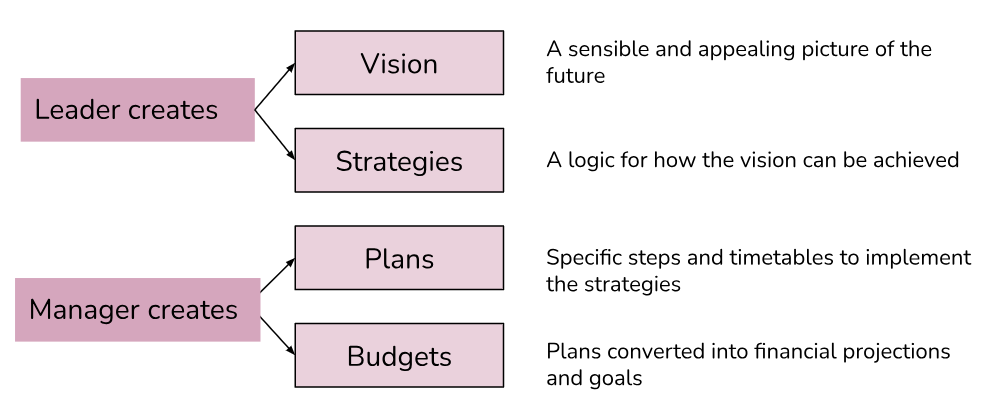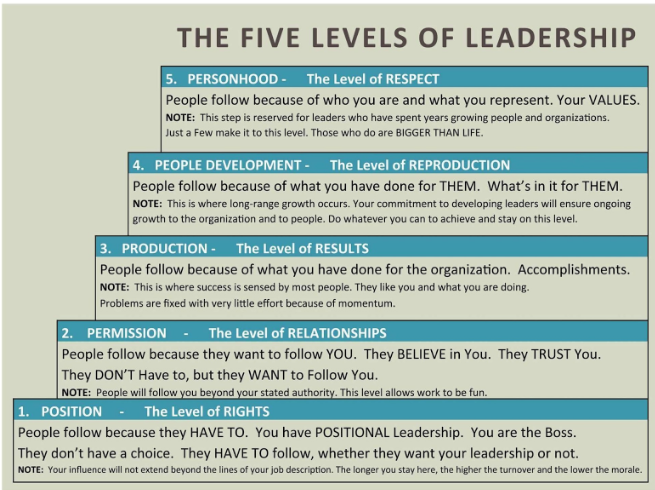Chap 1: Introduction to Leadership
1/19
Earn XP
Description and Tags
Name | Mastery | Learn | Test | Matching | Spaced |
|---|
No study sessions yet.
20 Terms
Leadership
Leadership is a process - involves influence - occurs within a group context - involves goals attainment
Which of the following best describes Trait Leadership?
A. Leadership is seen as a process involving interaction between leaders and followers
B. Leadership is based on the inherent qualities or characteristics of an individual
C. Leadership is assigned by an authority or position
D. Leadership is based on team-building and interaction
B
Which of the following best represents the Assigned Leadership concept?
A. A person is seen as a leader because of their personal qualities
B. A person is designated as a leader by formal authority
C. A person becomes a leader through interaction and influence
D. A person is self-selected as a leader based on their traits
B
Which type of leadership relies on an individual's personal qualities such as charisma, confidence, and intelligence?
A. Process Leadership
B. Assigned Leadership
C. Trait Leadership
D. Emergent Leadership
C
In the context of Process Leadership, which of the following is TRUE?
A. Leaders are born, not made
B. Leadership is an interactive process of goal-setting and influencing others
C. Leadership is assigned based on authority
D. Leadership is based solely on a person's personal traits
B
What is the main difference between Assigned Leadership and Emergent Leadership?
A. Assigned leadership is based on personal traits, while emergent leadership is based on formal authority
B. Assigned leadership comes from formal authority, while emergent leadership comes from the group’s acceptance of an individual
C. Assigned leadership is based on group dynamics, while emergent leadership is based on hierarchical structures
D. Assigned leadership is always better than emergent leadership
B
Is the leader and manager the same person ?
Leader can both hold official and non-official positions in the hierarchy, only for qualified individuals - who have the dream & vision
Manager : 3 levels: top-middle- line = the authority, function - who make the dream, vision become a actual plan
Leader vs Manager at the organizational level

Which of the following best distinguishes Managers from Leaders?
A. Managers focus on planning, organizing, and ensuring that tasks are completed according to deadlines, while leaders focus on creating a vision and inspiring people to follow it
B. Managers inspire and energize their teams to achieve long-term goals, while leaders are more concerned with setting rules and procedures for daily operations
C. Managers communicate goals and align people with a vision, while leaders allocate resources and solve day-to-day problems
D. Managers build teams and coalitions through vision, while leaders focus on problem-solving and time management
Answer: A
Explanation: Managers handle the practical aspects of an organization, like planning and organizing resources, whereas leaders focus on setting direction, creating a vision, and motivating others to follow it.
Which of the following activities is typically associated with Managers rather than leaders?
A. Creating a vision
B. Allocating resources
C. Building teams and coalitions
D. Inspiring and energizing people
B
Which of the following activities is more aligned with Leadership than Management?
A. Setting time tables and allocating resources for specific tasks
B. Establishing rules, procedures, and developing incentives
C. Communicating goals, building teams, and seeking commitment from employees
D. Providing structure and making job placements to ensure organizational efficiency
Answer: C
Explanation: Leadership focuses on communication, team-building, and gaining the commitment of employees toward a vision.
Managers, on the other hand, concentrate on creating structure, setting timelines, and developing operational procedures.

05 Levels of Leadership
At which level of leadership do people follow primarily because of who you are and what you represent?
A. Position
B. Production
C. Personhood
D. Permission
Answer: C
Explanation: The Personhood level is the highest level of leadership, where people follow a leader because of their values and who they have become over time. This level is achieved by only a few leaders and is based on respect and legacy.
Which level of leadership is characterized by developing others, ensuring long-term organizational growth, and is focused on what the leader has done for others?
A. People Development
B. Production
C. Permission
D. Position
Answer: A
Explanation: The People Development level is where leaders focus on reproducing other leaders by helping them grow. At this level, the focus is on developing people for the future, which ensures the organization's ongoing success.
What differentiates the Production level of leadership from the Position level?
A. Production focuses on developing people, while Position is about gaining trust.
B. At the Production level, people follow because of the leader's accomplishments, while at the Position level, people follow because they are obligated to.
C. Production is about values and legacy, while Position is about relationships.
D. At the Production level, people follow due to personal respect, while at the Position level, they follow because of long-term growth.
Answer: B
Explanation: At the Production level, leadership is defined by the leader’s results and achievements within the organization, whereas at the Position level, people follow because of the leader's authority and position, not because of respect or trust.
Which of the following is true about the Permission level of leadership?
A. People follow because they want to, based on the relationship and trust they have with the leader
B. People follow because they have to, based solely on the leader’s authority
C. People follow because the leader develops them into future leaders
D. People follow because of the leader’s accomplishments for the organization
Answer: A
Explanation: The Permission level focuses on relationships and trust. People follow leaders at this level because they believe in them and choose to follow, not because they are obligated to.
What is the primary characteristic of the Position level of leadership?
A. People follow because of trust and strong relationships
B. People follow due to the leader's influence on personal and professional growth
C. People follow because the leader is in a formal authority position, and they have no choice
D. People follow because of the leader’s proven success in achieving results
Answer: C
Explanation: The Position level is the entry-level of leadership, where people follow because of the leader’s formal authority or title. Influence does not extend beyond the leader’s job description, and the relationship is purely hierarchical.
At which level of leadership do leaders begin to see the effects of momentum and success, where problems are solved with little effort because of prior achievements?
A. Position
B. People Development
C. Production
D. Personhood
Answer: C
Explanation: At the Production level, success is evident through the leader’s achievements and the results they bring to the organization. This creates momentum, making it easier to address challenges and sustain organizational growth.
The Personhood level of leadership is characterized by:
A. People follow out of respect for the leader's values and lifetime of contributions
B. People follow because the leader has built strong relationships and trust
C. People follow because of the leader’s position in the organization
D. People follow because the leader has produced tangible results for the organization
Answer: A
Explanation: The Personhood level is the pinnacle of leadership, where people follow because of the leader's long-standing contributions and values. Leaders at this level are respected not just for their actions but for who they are as individuals.
Which leadership level is likely to result in higher turnover and lower morale if a leader remains at this stage too long?
A. People Development
B. Production
C. Position
D. Personhood
Answer: C
Explanation: The Position level, where people follow only because they have to, can lead to low morale and high turnover if the leader does not evolve beyond positional authority and fails to build trust or relationships with their team.